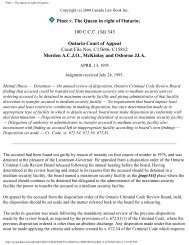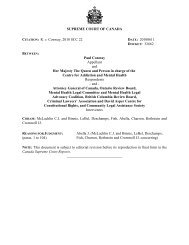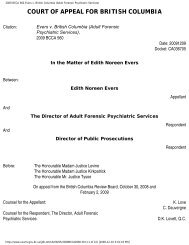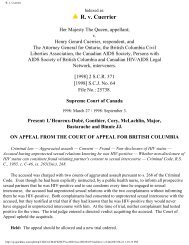IN THE MATTER OF PART XX.1 (Mental Disorder) - British ...
IN THE MATTER OF PART XX.1 (Mental Disorder) - British ...
IN THE MATTER OF PART XX.1 (Mental Disorder) - British ...
You also want an ePaper? Increase the reach of your titles
YUMPU automatically turns print PDFs into web optimized ePapers that Google loves.
<strong>IN</strong> <strong>THE</strong> <strong>MATTER</strong> <strong>OF</strong> <strong>PART</strong> <strong>XX.1</strong> (<strong>Mental</strong> <strong>Disorder</strong>) <strong>OF</strong> <strong>THE</strong> CRIM<strong>IN</strong>AL CODE<br />
R.S.C. 1985 c. C-46, as amended 1991, c. 43<br />
AND<br />
<strong>THE</strong> BRITISH COLUMBIA REVIEW BOARD<br />
<strong>IN</strong> <strong>THE</strong> <strong>MATTER</strong> <strong>OF</strong> <strong>THE</strong><br />
DISPOSITION HEAR<strong>IN</strong>G <strong>OF</strong><br />
LAUR<strong>IN</strong>A MARIE AUNE<br />
HELD AT: Forensic Psychiatric Hospital<br />
Port Coquitlam, BC<br />
August 21, 2003<br />
BEFORE: CHAIRPERSON: B. Walter<br />
MEMBERS: Dr. G. Laws, psychiatrist<br />
N. Avison<br />
APPEARANCES: ACCUSED/PATIENT: Laurina Marie Aune<br />
ACCUSED/PATIENT COUNSEL: A. Bryant<br />
HOSPITAL/CL<strong>IN</strong>IC: B. Fisher Dr. L. Meldrum<br />
ATTORNEY GENERAL: L. Hillaby
1<br />
2<br />
3<br />
4<br />
5<br />
6<br />
7<br />
8<br />
9<br />
10<br />
11<br />
12<br />
13<br />
14<br />
15<br />
16<br />
17<br />
18<br />
19<br />
20<br />
21<br />
22<br />
23<br />
24<br />
25<br />
CHAIRPERSON: On August 21, 2003 the <strong>British</strong> Columbia Review Board<br />
convened a first hearing pursuant to s. 672.47(1) of the Criminal Code to<br />
make a disposition in the matter of Laurina Marie Aune who is now age<br />
26.<br />
Ms. Aune comes under the jurisdiction of this Board as a result of a<br />
charge of second degree murder contrary to s. 235 of the Criminal Code.<br />
In an indictment found at Exhibit 1 it is alleged that on or about November<br />
1, 2002 Ms. Aune killed her then two-year-old daughter. The<br />
circumstances of the offence were disclosed in the course of a psychiatric<br />
interview on December 16, 2002, which occurred during an investigation<br />
into the young child's whereabouts, as she had not been seen for some<br />
six weeks or more. Following her disclosure in the context of that<br />
psychiatric interview, she later, on the same date, disclosed the details of<br />
her actions and her activities immediately following the index offence in a<br />
taped police interview, part of which may be found at Exhibit 6 in these<br />
proceedings. A search of the accused's apartment followed on December<br />
17, 2002, whereupon the young child's remains were discovered and the<br />
accused was arrested.<br />
On July 17th, 2003, following her assessment at the Forensic<br />
Psychiatric Hospital, the accused was found NCRMD by the Supreme<br />
Court of <strong>British</strong> Columbia seated at Nanaimo. Her further disposition was<br />
deferred to the <strong>British</strong> Columbia Review Board. The accused has been<br />
committed to FPH since the date of that verdict by virtue of a warrant of<br />
committal made on the same date.<br />
Application to Exclude Public
1<br />
2<br />
3<br />
4<br />
5<br />
6<br />
7<br />
8<br />
9<br />
10<br />
11<br />
12<br />
13<br />
14<br />
15<br />
16<br />
17<br />
18<br />
19<br />
20<br />
21<br />
22<br />
23<br />
24<br />
25<br />
In the course of three days of trial and expert evidence culminating<br />
in the NCRMD verdict, Mr. Justice Taylor, ordered the sealing and<br />
withholding of various exhibits tendered in support of the accused's<br />
verdict. These include Exhibit 1, an admission of facts which was released<br />
with certain passages deleted and with attachments thereto withheld; a<br />
package of forensic photographs detailing the murder investigation;<br />
Exhibit 3, a video recording of the accused prior to her arrest; Exhibit 4, an<br />
audio interview of the accused upon arrest. Justice Taylor considered<br />
those exhibits sufficiently prejudicial and unnecessary such as to<br />
persuade him to withhold their broader distribution and publication.<br />
On convening this, Ms. Aune's first hearing before the Board, her<br />
assigned counsel, Mr. A. Bryant brought an application pursuant to s.<br />
672.5(6) of the Criminal Code to exclude members of the public from the<br />
hearing or, in the alternative, to exclude members of the public, including<br />
the media, from certain parts or aspects of the proceeding. In an<br />
application filed on the 13th of August, Mr. Bryant based his request for an<br />
order banning the publication of certain selected portions of the evidence<br />
on sections 7 and 24(1) of the Charter of Rights and Freedoms, however<br />
he did not see fit to pursue or make submissions on that aspect of his<br />
application at the hearing.<br />
On the matter of the application to exclude pursuant to s. 672.5(6),<br />
it became clear during the course of his submissions that Mr. Bryant, in<br />
lieu of a total exclusion of members of the public, wished to have such<br />
exclusion apply only to a representative of the Vancouver Sun who was in<br />
attendance, in respect of what he considered prejudicial aspects of the<br />
2
1<br />
2<br />
3<br />
4<br />
5<br />
6<br />
7<br />
8<br />
9<br />
10<br />
11<br />
12<br />
13<br />
14<br />
15<br />
16<br />
17<br />
18<br />
19<br />
20<br />
21<br />
22<br />
23<br />
24<br />
25<br />
psychiatric evidence he believed might be tendered at the disposition<br />
hearing.<br />
In considering the application the Review Board invited<br />
submissions from counsel for the other parties. Ms. Fisher, on behalf of<br />
the Director of AFPS, took no opening position. Mr. Hillaby, representing<br />
the Attorney General of <strong>British</strong> Columbia, submitted that because the<br />
information in question was likely already publicly known, the hearing<br />
should proceed in an open, unrestricted manner.<br />
In order to provide a full opportunity for all perspectives to be<br />
heard, aired and considered, the Board also invited Ms. Pemberton, a<br />
reporter for the Vancouver Sun, to make submissions or to comment on<br />
the request for a closed hearing. She was provided with a brief break in<br />
the proceedings to enable her to contact her employer’s legal advisers.<br />
Following that hiatus she returned indicating that while her legal advice<br />
was to persuade the Board to conduct its proceeding in an open and<br />
public manner, she had no objection to the Board hearing the application<br />
for exclusion itself in- camera. Thereafter she left the hearing room and<br />
the evidence in support of the application to exclude was heard.<br />
Mr. Bryant called Dr. Meldrum, with the objective of putting on the<br />
record psychiatric evidence supporting the theory that an open hearing<br />
and the possible publication of the evidence to be adduced at the<br />
disposition hearing could conceivably impair his client's mental state, her<br />
treatment and certainly her community reintegration. He was also<br />
concerned that publication of some of the more disturbing details could<br />
expose the accused to risk of harm from staff or co-patients at this<br />
3
1<br />
2<br />
3<br />
4<br />
5<br />
6<br />
7<br />
8<br />
9<br />
10<br />
11<br />
12<br />
13<br />
14<br />
15<br />
16<br />
17<br />
18<br />
19<br />
20<br />
21<br />
22<br />
23<br />
24<br />
25<br />
hospital, as well as retaliation from staff in a community psychiatric setting<br />
she may come to reside in at a future time.<br />
Dr. Meldrum gave evidence that, while theoretically the stress of<br />
publication of aspects of the evidence could conceivably cause her patient<br />
stress in some of the areas mentioned by Mr. Bryant, her experience with<br />
her patient and her patient's reactions in hospital to date, including her<br />
reactions to previous publications following her trial, left her unable to<br />
predict with any degree of certainty the probability that additional<br />
publication would cause her client to relapse to psychosis or substantially<br />
derail her treatment progress.<br />
Dr. Meldrum also gave evidence that, a Vancouver Sun article,<br />
published on July 18, 2003, including certain details of the index offence,<br />
did not appear to overtly distress or decompensate her patient, nor was<br />
Ms. Aune demonstrating excessive distress at the prospect of media<br />
coverage at this disposition hearing beyond some mild annoyance and a<br />
sense of intrusion on her privacy.<br />
In terms of responding to possible pejorative media coverage, Dr.<br />
Meldrum outlined a plan in place on the occasion of the accused's trial<br />
under which hospital staff were prepared to monitor patients’ access to<br />
media, and assess the impact of same. She indicated that,<br />
notwithstanding some cursory coverage of the accused's trial, no<br />
concerns came to fruition and no special measures were found to be<br />
necessary to suppress coverage or to protect the accused.<br />
In considering the evidentiary submissions on the application the<br />
Board came to the conclusion that it would not exercise its power to<br />
4
1<br />
2<br />
3<br />
4<br />
5<br />
6<br />
7<br />
8<br />
9<br />
10<br />
11<br />
12<br />
13<br />
14<br />
15<br />
16<br />
17<br />
18<br />
19<br />
20<br />
21<br />
22<br />
23<br />
24<br />
25<br />
exclude members of the public from the disposition review hearing,<br />
without prejudice to Mr. Bryant's opportunity to renew his request at<br />
various strategic points in the hearing.<br />
Our reasons for denying the application are as follows. Our<br />
reading of the Criminal Code, and in particular s. 672.5(6), s. 672.51(7)<br />
and s. 672.51(11) persuade us that the legislation intends and presumes<br />
hearings of the Review Boards to be open to the public; otherwise, the<br />
power to exclude and the power to withhold disposition information would<br />
be redundant. The rationale for the presumption of openness is, of<br />
course, found in the long held value that openness to public scrutiny is<br />
fundamental to accountability and impartiality in the administration of<br />
justice. Nonetheless, it has been considered and determined by the B.C.<br />
Court of Appeal in the case of Blackman (B.C.C.A., Jan. 24, 1995,<br />
CA017480) and, more recently, by the Ontario Court of Appeal in Oshawa<br />
This Week (2002 (0J) No. 554), that the power to exclude under s.<br />
672.5(6) though valid, must be exercised with great caution; implemented<br />
on a case-by-case inquiry, and ultimately based upon evidence which<br />
satisfies both branches or criteria articulated in the subsection.<br />
The first branch of that test has to do with the best interests of the<br />
accused. That test has been interpreted to include evidence that the<br />
accused's treatment or mental state would be seriously compromised or<br />
interfered with by the attendance of the public and subsequent publication<br />
of the proceedings. Cases such as Blackman (supra) and the <strong>British</strong><br />
Columbia Review Board's decision in Fisher indicate that such a<br />
determination must be based on cogent, clear and compelling evidence<br />
5
1<br />
2<br />
3<br />
4<br />
5<br />
6<br />
7<br />
8<br />
9<br />
10<br />
11<br />
12<br />
13<br />
14<br />
15<br />
16<br />
17<br />
18<br />
19<br />
20<br />
21<br />
22<br />
23<br />
24<br />
25<br />
that public attendance and publication would (inter alia) trigger a<br />
decompensation in the patient or would expose the patient to risk from<br />
others.<br />
The second branch of the test under s. 672.5(6) holds that the<br />
decision to exclude must not be contrary to the public’s interest in open<br />
proceedings. The case law makes it clear that the best interest of the<br />
accused is not the determining factor, nor is it necessarily identical to the<br />
public interest. In all cases the Board must weigh the accused's interests<br />
in a closed hearing against the value of openness and accountability. In<br />
Oshawa This Week (supra), the Ontario Court of Appeal said that the<br />
Ontario Review Board should, in each case, assess whether the exclusion<br />
or ban on publication is necessary to protect the legitimate interests of the<br />
mentally disordered offender and whether the salutary effects (for the<br />
accused) of a ban outweigh the deleterious effects on freedom of<br />
expression.<br />
In applying these tests, we consider the following evidence with<br />
respect to Ms. Aune's case. According to the assessment evidence, we<br />
have been provided, she appears at this early stage in her treatment quite<br />
affectively insulated from the facts surrounding the index offence. We<br />
also note that publication of critical information has already occurred in the<br />
form of the aforementioned article published in the Vancouver Sun on July<br />
18th, 2003. It chronicled the circumstances and the process whereby the<br />
court arrived at the NCRMD verdict. We have no evidence that<br />
publication caused Ms. Aune any decompensation or significant setback<br />
in terms of her treatment. Indeed, Dr. Meldrum indicated that the accused<br />
6
1<br />
2<br />
3<br />
4<br />
5<br />
6<br />
7<br />
8<br />
9<br />
10<br />
11<br />
12<br />
13<br />
14<br />
15<br />
16<br />
17<br />
18<br />
19<br />
20<br />
21<br />
22<br />
23<br />
24<br />
25<br />
did not decompensate or suffer any inordinate distress as a result of the<br />
publication of that article, nor did its publication appear to expose her to<br />
any inordinate or unmanageable personal risk within this institution.<br />
Given the publication of that article, it is clear as well that the<br />
circumstances of the index offence and subsequent events are widely<br />
known, along with the finding that Ms. Aune was suffering from a<br />
disordered state of mind which served to exempt her from criminal<br />
responsibility.<br />
Although Justice Taylor found that on July 17, 2003 the accused<br />
was in a somewhat fragile state, Dr. Meldrum indicates that she is no<br />
more fragile on the date of the current hearing. She is, therefore,<br />
unprepared to predict her patient's imminent decompensation as a result<br />
of an open hearing.<br />
On the basis of that evidence, we feel that the first branch of the<br />
test under 672.5(6) has not been met. In other words, we have not been<br />
provided with compelling evidence that an open hearing, including the<br />
potential publication of aspects and outcomes of this proceeding, would<br />
predictably harm this patient's treatment progress in a substantial way.<br />
To the extent that the first branch of the test has not been satisfied,<br />
we do not need to discuss the public interest aspect; the second branch of<br />
the test. The hearing was therefore declared open to the public and to the<br />
media.<br />
<strong>THE</strong> DISPOSITION HEAR<strong>IN</strong>G<br />
At the outset of the disposition hearing exhibits were marked and<br />
all parties were invited to state their positions as to disposition. The<br />
7
1<br />
2<br />
3<br />
4<br />
5<br />
6<br />
7<br />
8<br />
9<br />
10<br />
11<br />
12<br />
13<br />
14<br />
15<br />
16<br />
17<br />
18<br />
19<br />
20<br />
21<br />
22<br />
23<br />
24<br />
25<br />
parties, including the accused, agreed that the appropriate disposition to<br />
be made should be one of custody for a 12-month period.<br />
In arriving at the appropriate and least restrictive disposition in this<br />
matter in accordance with s. 672.54 of the Criminal Code, the Review<br />
Board considered the following written and oral evidence.<br />
We understand that in more recent times the accused has alleged<br />
that she was a victim of past childhood abuse around the age of eight.<br />
She has also acknowledged some history of depression. The assessment<br />
information also indicates the accused has self-reported her use of<br />
marijuana since adolescence and an increased use of that substance,<br />
proximate to the index offence.<br />
Collateral information gathered following the offence and<br />
documented in the assessment information provided to the court, raises<br />
the possibility of the presence of psychotic phenomena in Ms. Aune since<br />
her early teens. She is also described as somewhat socially isolated;<br />
financially and otherwise stressed; disorganized as a single parent, and<br />
having general coping difficulties. During the period following the birth of<br />
her child, the victim of the index offence, the accused received some<br />
mental health services due to, among other things, symptoms of<br />
depression. She has never received consistent psychiatric treatment or<br />
follow up. In January of 2002 she saw a psychologist but was not<br />
considered psychotic. In February 2002 she was prescribed Paxil by a<br />
general practitioner. In May 2002 she presented with paranoid delusional<br />
ideas. During the summer of 2002 she seemed to stabilize and improve<br />
in her effectiveness as a parent to her young child.<br />
8
1<br />
2<br />
3<br />
4<br />
5<br />
6<br />
7<br />
8<br />
9<br />
10<br />
11<br />
12<br />
13<br />
14<br />
15<br />
16<br />
17<br />
18<br />
19<br />
20<br />
21<br />
22<br />
23<br />
24<br />
25<br />
26<br />
27<br />
28<br />
29<br />
30<br />
31<br />
32<br />
33<br />
34<br />
35<br />
36<br />
Following her arrest she was, on December 19, 2002, admitted to<br />
FPH for assessment as to her fitness to stand trial and as to her mental<br />
state at the time of the index offence. The following quote is taken from<br />
Exhibit 9, a report Dr. Meldrum provided to the Court:<br />
Ms. Aune described herself to Dr. Randhawa as a worrier and<br />
stated she had been abused in the past by two different<br />
perpetrators and claimed that she had never disclosed this<br />
abuse to anyone in the past. She acknowledged that she had<br />
seen shadows in the dark which had begun when she was<br />
approximately age 13. She felt that these shadows were spirit<br />
visitations and that she has perceived spirits inside her and<br />
outside her. She felt that she received messages from these<br />
spirits and that she had been experiencing this at a greater<br />
intensity following the birth of her daughter. She appeared<br />
bewildered throughout the interview with Dr. Randhawa and<br />
her affect appeared blunted and downcast. She appeared<br />
distracted and appeared to be responding to auditory<br />
hallucinations. At times she was tangential in her thinking and<br />
of concern was her ongoing suicidal ideation. Dr. Randhawa's<br />
differential diagnosis included a psychosis (NOS) with the<br />
differential being bipolar mood disorder, schizoaffective<br />
disorder with the need to rule out an organic etiology to the<br />
psychosis. Dr. Randhawa felt that Ms. Aune met the criteria<br />
for certification and completed the first certificate under the<br />
<strong>Mental</strong> Health Act.<br />
Once Dr. Meldrum saw Ms. Aune she endorsed a similar diagnostic<br />
formulation and initiated the accused on medication. Unfortunately,<br />
although Ms. Aune improved progressively, she developed some<br />
significant side effects and her medication was changed from Risperidone<br />
to Olanzapine.<br />
Under close treatment and observation she was considered fit to<br />
stand trial by February. She was also subjected to neuro-psychological<br />
testing while at FPH. That testing revealed that Ms. Aune is of average or<br />
above-average intelligence and presents as generally normal in terms of<br />
her executive functioning. She is free from any acquired brain injuries or<br />
9
1<br />
2<br />
3<br />
4<br />
5<br />
6<br />
7<br />
8<br />
9<br />
10<br />
11<br />
12<br />
13<br />
14<br />
15<br />
16<br />
17<br />
18<br />
19<br />
20<br />
21<br />
22<br />
23<br />
24<br />
25<br />
26<br />
27<br />
28<br />
29<br />
30<br />
31<br />
32<br />
33<br />
neurological disease. The assessment also raised the possibility of a<br />
schizoid personality disorder. In the result Dr. Meldrum ultimately<br />
assigned a diagnosis of schizophrenia or schizoaffective disorder,<br />
although preferring schizophrenia in her clinical judgment: Exhibit 10.<br />
In that same report Dr. Meldrum also provides a detailed<br />
description of the index offence as disclosed by the accused. While we<br />
have no wish to belabour the somewhat grim and disturbing details<br />
surrounding the death of a young child, the following passage might be<br />
useful for future proceedings of this tribunal:<br />
Ms. Aune stated that because of her belief that people were<br />
coming up through the trap door to rape her she had a knife in a<br />
basket by the door. She stated she took this knife and walked Kyla<br />
towards the bathroom. She describes being "drawn there." She<br />
stated that in the bathroom she took off hers and Kyla's clothes<br />
because she wanted to be "physically closer" to Kyla and she didn't<br />
want their clothes to get messy. She stated that she had turned<br />
Kyla's back to her because "I wanted her to feel secure." She<br />
stated that she held Kyla between her legs and then hesitated a bit<br />
because she did not want to "cause her physical pain." She stated<br />
that she was concerned that she might not be effective in cutting<br />
Kyla's throat and that this would cause Kyla undue pain. She<br />
stated that her motivation at the time was to kill Kyla to end her<br />
pain: Exhibit 10.<br />
Further on, Dr. Meldrum also endorses Ms. Aune's belief that in cutting<br />
her daughter's throat she felt she was operating upon instructions. Ms.<br />
Aune endorsed such directives or commands in the course of her<br />
questioning by the Board at the disposition hearing.<br />
The Review Board also takes into account in the course of its<br />
deliberations an assessment report by Dr. Lohrasbe dated April 12, 2003<br />
and found at Exhibit 11. In that report Dr. Lohrasbe describes an<br />
intensive interview which occurred at the Forensic Psychiatric Hospital,<br />
during which he found the accused emotionally detached, indifferent and<br />
10
1<br />
2<br />
3<br />
4<br />
5<br />
6<br />
7<br />
8<br />
9<br />
10<br />
11<br />
12<br />
13<br />
14<br />
15<br />
16<br />
17<br />
18<br />
19<br />
limited in terms of her insight into the illness. Significantly, he found that<br />
even in April of 2003 the accused’s understanding of her actions remained<br />
impaired.<br />
In arranging this first hearing of the Review Board, we have been<br />
provided with additional disposition information in the form of victim impact<br />
statements found at Exhibit 19; a social history at Exhibit 20; an updated<br />
psychiatric report from Dr. Meldrum at Exhibit 21, and a report from Case<br />
Manager Dominguez at Exhibit 22.<br />
The social history, at Exhibit 20, adds little to the picture already<br />
assembled in the written assessments, reciting once again some aspects<br />
of the accused's developmental history and an apparent adolescent onset<br />
of some mild interest in the occult. It also underscores the accused's<br />
regular use of marijuana to the extent of two to four joints per day.<br />
In her new report at Exhibit 21 submitted to this tribunal, Dr.<br />
Meldrum also once again summarizes and reiterates the accused's social<br />
and developmental history.<br />
The accused currently resides on the Dogwood Unit at FPH, which<br />
serves as a multi-level somewhat secure unit for female patients at FPH<br />
and where Ms. Aune was, at least until August 5, 2003, overall<br />
20<br />
cooperative, non-impulsive and non-aggressive.<br />
According to Dr.<br />
21<br />
22<br />
23<br />
24<br />
Meldrum the accused remains limited in terms of her insight in the sense<br />
that she continues to have difficulty describing her mental illness or its<br />
symptoms and she does not appear to fully understand its treatment<br />
needs. Though passively compliant, she also appears somewhat<br />
11
1<br />
2<br />
3<br />
4<br />
5<br />
6<br />
7<br />
8<br />
9<br />
10<br />
11<br />
12<br />
13<br />
14<br />
15<br />
16<br />
17<br />
18<br />
19<br />
20<br />
21<br />
22<br />
23<br />
24<br />
25<br />
ambivalent about her medication. There are no plans to dramatically alter<br />
her treatment regime at this time.<br />
Dr. Meldrum augmented her report verbally, indicating that Ms.<br />
Aune's past familial and social relationships cannot be relied upon as<br />
active, tangible supports in aid of her community reintegration, at least<br />
into the foreseeable future.<br />
She also reviewed the accused's mental health history, including<br />
brief attendances at Nanaimo <strong>Mental</strong> Health Services for anxiety, a GP for<br />
depression and a psychologist for a variety of somewhat vague<br />
complaints and coping difficulties. As stated above she has never<br />
received consistent or ongoing diagnosis or treatment for a psychotic<br />
illness. Dr. Meldrum also considers, in terms of her substance history,<br />
that future use of even marijuana is likely to negatively affect her current<br />
level of mental stability.<br />
Dr. Meldrum was asked to review Ms. Aune's course in hospital<br />
since her admission in December of 2002. She reminded us that the<br />
accused was severely and acutely psychotic on admission to the point<br />
where she was actively delusional, hallucinating and presenting with both<br />
suicidal ideation, as well as homicidal thoughts toward staff and others.<br />
She was considered an acute risk to herself and was closely monitored for<br />
some time. Once her symptoms resolved under treatment she presented<br />
as mostly pleasant, cooperative, though somewhat superficial and nondisclosive.<br />
She remains non-disclosive and disengaged in terms of her<br />
internal mental processes. She appears to have difficulty describing or<br />
verbalizing her mental and emotional state, although she does appear<br />
12
1<br />
2<br />
3<br />
4<br />
5<br />
6<br />
7<br />
8<br />
9<br />
10<br />
11<br />
12<br />
13<br />
14<br />
15<br />
16<br />
17<br />
18<br />
19<br />
20<br />
21<br />
22<br />
23<br />
24<br />
25<br />
able to discuss the details of the index offence without apparent affect or<br />
undue distress. At this point Dr. Meldrum believes Ms. Aune's<br />
schizophrenic disorder is marked by profound negative symptoms.<br />
Given her presentation, the treatment team sees it as a priority to<br />
develop a working, trusting, therapeutic relationship with Ms. Aune. Dr.<br />
Meldrum believes that this will take some time to accomplish. She has no<br />
imminent plans to change Ms. Aune's medications and has initiated a<br />
referral and assessment by drug and alcohol counselling services in the<br />
hospital. Ms. Aune may also be provided with symptom management<br />
programming.<br />
As to risk assessment, Dr. Meldrum cites the accused’s ongoing<br />
lack of engagement and insight; the absence of any objective evidence of<br />
current active, overt psychotic symptoms; concerns about the possibility of<br />
reintegrating Ms. Aune to the Nanaimo community given the grisly nature<br />
of the index offence; the absence of any discharge plan or aspirations at<br />
this point in time, as well as the absence of any significant identifiable,<br />
social supports.<br />
In arguing for a disposition of custody, Dr. Meldrum also requests<br />
that we prohibit any unescorted community access until such time as the<br />
accused becomes more disclosive and more engaged in her own<br />
treatment.<br />
Following Dr. Meldrum's evidence and her examination by all<br />
parties and members of the Review Board, Mr. Bryant presented his client<br />
to answer questions from the parties. In answer to questions from Mr.<br />
Hillaby, Ms. Aune acknowledged that she believes she may have a mental<br />
13
1<br />
2<br />
3<br />
4<br />
5<br />
6<br />
7<br />
8<br />
9<br />
10<br />
11<br />
12<br />
13<br />
14<br />
15<br />
16<br />
17<br />
18<br />
19<br />
20<br />
21<br />
22<br />
23<br />
24<br />
25<br />
illness. She acknowledged that she had experienced episodic psychotic<br />
phenomena and memory problems since age 13. She confirmed she felt<br />
commanded or directed in her actions at the time of the index offence.<br />
She has not had strange experiences since approximately the time of her<br />
admission or at least since before her NCRMD hearing. Her presentation<br />
while unfailingly polite was at the same time eerily calm.<br />
As indicated at the outset of these reasons, all parties were at<br />
consensus with respect to the appropriate disposition to be made.<br />
In support of finding Ms. Aune a significant threat such as warrants<br />
our jurisdiction over her, we further consider the recency of acute<br />
symptoms; the intensity of her violent and homicidal thoughts present at<br />
admission; her untreated history of substance abuse, resumption of which<br />
would certainly raise the risk of relapse and therefore the risk of harm to<br />
others. We also consider an incident which occurred during the past<br />
weekend during which Ms. Aune, labouring under misperceptions,<br />
demonstrated what appears to have been impulsive behaviour resulting in<br />
a significant assault on a co-patient. That event is currently the subject of<br />
police investigation.<br />
We note that Ms. Aune has demonstrated no evidence of a grief<br />
reaction to the loss of her daughter and Dr. Meldrum believes this is<br />
probably due to the profundity of the negative symptoms attributable to<br />
her illness.<br />
In summary, we had no hesitation concluding that, considering the<br />
horrific nature of the index offence; the acuteness of the accused's illness<br />
at the time; the early stages of her but partial recovery; her lack of insight;<br />
14
1<br />
2<br />
3<br />
4<br />
5<br />
6<br />
7<br />
8<br />
9<br />
her lack of community supports, and her recent relapse to aggressive<br />
behaviour, she satisfies the criteria outlined in Winko, which define the<br />
concept of significant threat to public safety.<br />
Having satisfied that threshold determination and given the<br />
manifest absence of anything amounting to a discharge plan or<br />
appropriate and necessary community supports, our least restrictive and<br />
least onerous alternative was to detain Ms. Aune in custody at FPH under<br />
circumstances and conditions outlined in the presence of all parties and<br />
counsel.<br />
<br />
/la edit ck<br />
15


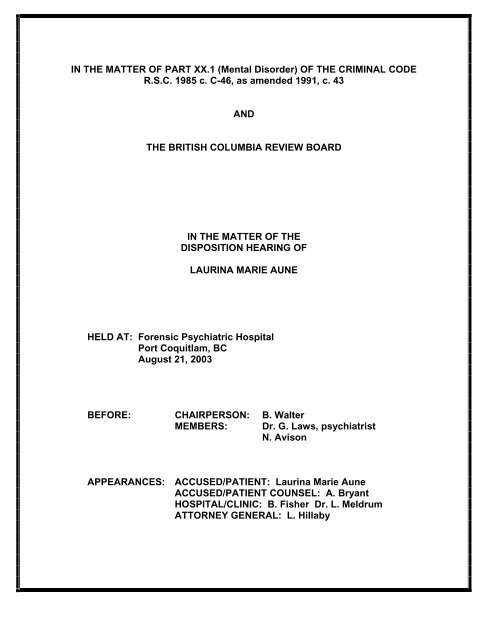
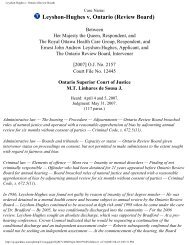
![LaFortune [LaFortunate] (Re) - British Columbia Review Board](https://img.yumpu.com/42779845/1/190x245/lafortune-lafortunate-re-british-columbia-review-board.jpg?quality=85)
